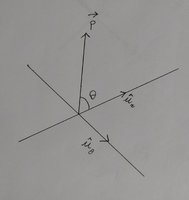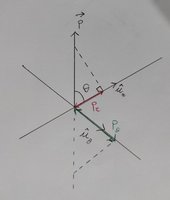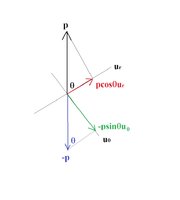I'm having troubles in understanding how my physics textbook finds the polar components of the vector [MATH]\vec{p}[/MATH] (I've uploaded two images): by book introduces two orthogonal vectors [MATH]\hat{u}_r[/MATH] and [MATH]\hat{u}_\theta[/MATH] and says that [MATH]\vec{p}=p \cos \theta \hat{u}_r-p \sin \theta \hat{u}_\theta[/MATH].
If I'm not wrong, the components should be the projections of [MATH]\vec{p}[/MATH] onto [MATH]\hat{u}_r[/MATH] and [MATH]\hat{u}_\theta[/MATH], that is [MATH]\vec{p}=p_r \hat{u}_r+p_\theta \hat{u}_\theta[/MATH] (in red and green in the second picture), but while I'm fine with the fact that the projection onto [MATH]\hat{u}_r[/MATH] is [MATH]p_r=p \cos \theta[/MATH] I don't understand the minus sign in the projection onto [MATH]\hat{u}_\theta[/MATH] is [MATH]p_\theta=-p \sin \theta[/MATH].
The main doubt is the fact that since by hypothesis [MATH]\hat{u}_r[/MATH] and [MATH]\hat{u}_\theta[/MATH] are orthogonal, the angle between [MATH]\vec{p}[/MATH] and [MATH]\hat{u}_\theta[/MATH] should be [MATH]\theta+\pi/2[/MATH], so the angle between the extension of [MATH]\vec{p}[/MATH] (the one dashed under [MATH]\vec{p}[/MATH] in my drawing) and [MATH]\hat{u}_\theta[/MATH] should be [MATH]\pi-\pi/2-\theta=\pi/2-\theta[/MATH] and so [MATH]p_\theta=p \cos (\pi/2-\theta)=p \sin \theta[/MATH]; so I don't get the minus sign. Where am I doing a mistake?
If I'm not wrong, the components should be the projections of [MATH]\vec{p}[/MATH] onto [MATH]\hat{u}_r[/MATH] and [MATH]\hat{u}_\theta[/MATH], that is [MATH]\vec{p}=p_r \hat{u}_r+p_\theta \hat{u}_\theta[/MATH] (in red and green in the second picture), but while I'm fine with the fact that the projection onto [MATH]\hat{u}_r[/MATH] is [MATH]p_r=p \cos \theta[/MATH] I don't understand the minus sign in the projection onto [MATH]\hat{u}_\theta[/MATH] is [MATH]p_\theta=-p \sin \theta[/MATH].
The main doubt is the fact that since by hypothesis [MATH]\hat{u}_r[/MATH] and [MATH]\hat{u}_\theta[/MATH] are orthogonal, the angle between [MATH]\vec{p}[/MATH] and [MATH]\hat{u}_\theta[/MATH] should be [MATH]\theta+\pi/2[/MATH], so the angle between the extension of [MATH]\vec{p}[/MATH] (the one dashed under [MATH]\vec{p}[/MATH] in my drawing) and [MATH]\hat{u}_\theta[/MATH] should be [MATH]\pi-\pi/2-\theta=\pi/2-\theta[/MATH] and so [MATH]p_\theta=p \cos (\pi/2-\theta)=p \sin \theta[/MATH]; so I don't get the minus sign. Where am I doing a mistake?
Attachments
Last edited:



